Woolly clematis
(Clematis lanuginosa)

Description
Clematis lanuginosa is a flowering perennial plant native to China, Korea, and Japan. It is a member of the Ranunculaceae family, which also includes buttercups and anemones. Clematis lanuginosa is commonly known as the woolly clematis or old man's beard due to the white, fluffy hairs that cover the plant's stems and leaves. This article will provide an in-depth look at Clematis lanuginosa, including its description, habitat, cultivation, and uses. Description Clematis lanuginosa is a deciduous climbing plant that can grow up to 4 meters in height. Its stems are thin and wiry, and they are covered in a dense layer of white hairs, giving the plant a woolly appearance. The leaves are also covered in fine hairs and are typically palmately lobed with three to five leaflets. The flowers of Clematis lanuginosa are bell-shaped and come in a range of colors, including white, pink, and lavender. They bloom in the summer and early fall, and they are followed by feathery seed heads that are dispersed by the wind. Habitat Clematis lanuginosa is native to a wide range of habitats, including forests, hillsides, and streambanks. It prefers moist, well-draining soils and partial to full sun exposure. The plant is hardy to USDA zones 4-8, and it can withstand temperatures as low as -30°C (-22°F). Cultivation Clematis lanuginosa is a popular ornamental plant in gardens and landscapes. It is easy to grow and requires minimal care. Here are some tips for growing Clematis lanuginosa: Soil: Clematis lanuginosa prefers moist, well-draining soils. Amend heavy soils with organic matter to improve drainage. Sun: Clematis lanuginosa thrives in partial to full sun exposure. Provide some shade during the hottest part of the day in warmer climates. Water: Water regularly during the growing season to keep the soil moist. Avoid overwatering, which can lead to root rot. Fertilizer: Feed Clematis lanuginosa with a balanced fertilizer in the spring and again in the summer. Pruning: Prune Clematis lanuginosa in late winter or early spring before new growth appears. Cut back the previous year's growth to 30-45cm (12-18 inches) above the ground. This will encourage bushier growth and more blooms. Uses Clematis lanuginosa has a long history of medicinal and ornamental uses. In traditional Chinese medicine, the plant is used to treat rheumatism, stomach disorders, and skin conditions. The plant's roots, stems, and leaves are used for their medicinal properties. In gardens and landscapes, Clematis lanuginosa is prized for its attractive foliage and showy flowers. It is often grown on trellises, arbors, and fences to add vertical interest to the garden. The plant can also be used as a ground cover or to cascade over walls or rocks. Conclusion Clematis lanuginosa is a beautiful and versatile plant that is well-suited to gardens and landscapes. Its woolly appearance and showy flowers make it a popular choice for gardeners, and its medicinal properties have been recognized for centuries. With a little care and attention, Clematis lanuginosa can thrive in a variety of settings and provide beauty and interest for years to come.
Taxonomic tree:







